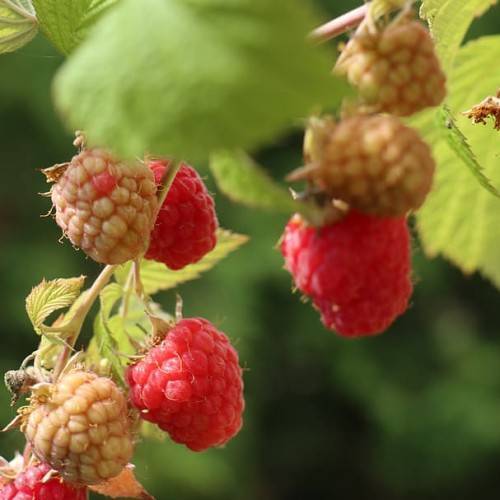
red raspberry
Rubus idaeus 'NR7' BUSHEL AND BERRY RASPBERRY SHORTCAKE
Cycle:
Perennial
Watering:
Average
Hardiness Zone:
4 - 9
Flowers:
Flowers
Sun:
Full sun,part shade
Fruits:
Fruits Ready In
Edible:
Yes
Leaf:
Yes
Growth Rate:
High
Maintenance:
Moderate
Care Level:
Medium
watering
Red Raspberry (Rubus idaeus 'NR7' Bushel and Berry Shortcake) should be watered approximately once a week or when the soil feels dry to the touch. Consider applying a 2-3 inch layer of mulch over the soil to regulate the moisture levels and prevent competing weeds. Additionally, be sure to water at the roots of the plant in order to prevent leaf diseases. Raspberry bushes prefer a consistently moist environment, so during extreme temperatures water more frequently. In hot summer months, raspberry plants may need water every 5-7 days.
sunlight
Red raspberry (Rubus idaeus 'NR7' BUSHEL AND BERRY RASPBERRY SHORTCAKE) is a an early-bearing plant species that requires 6-8 hours of direct sunlight each day in order to thrive. It is best to provide full sun during the morning hours when the risk of sunburn is lower. The plant should be in full sun by mid-morning and allowed to stay in the sun until late afternoon, when the intensity of the light has started to fade. If placed in an area where the sun is blocked by buildings or trees, the plants may not produce as many flowers or fruit. Red raspberry plants should receive at least 6-8 hours of direct sunlight each day, regardless of the season.
pruning
Pruning of the Red Raspberry (Rubus idaeus 'NR7') plant is best done in late winter or early spring. Pruning should be done with sharp pruning shears to ensure a clean cut. Removing dead or unhealthy canes from the base of the bush is the best way to start the pruning process. The next step is to remove any canes that are spindly and are located in the center of the bush. Then, any suckers and canes growing outside the intended shape of the bush should be cut off. For heavier pruning, all canes of the current season’s growth can be pruned back to 6–8 inches (15–20 cm). This will promote strong, thicker canes with vigorous growth the following season. Additionally, dead or damaged shoots should be removed from the bottom up based on their position near good canes. Finally, canes can be thinned, leaving 4 to 6 of the strongest canes per plant.
Season
Hardiness Map
FAQ
Should I Mulch Around Raspberry Trees?
Yes, absolutely! Mulching around raspberry trees is beneficial as it helps to prevent weeds, retain moisture and capture important nutrients from leaching away. You should apply a layer of organic mulch such as straw, grass clippings, compost, sawdust, or bark across the base of the plants in late winter for best results. This will also help to insulate the roots and prevent the spread of disease. Make sure the mulch isn't too thick; a 3-inch layer should be enough.
Do Raspberry Trees Attract Beneficial Pollinators?
Yes, raspberry trees do attract beneficial pollinators. These pollinators are primarily bees and other small insects that feed on the nectar and pollen of raspberry flowers. These pollinators are important for the reproduction of raspberries, as they help transfer pollen from male to female flowers to enable fruit production. Not only do the pollinators benefit raspberry trees by ensuring fruit production, but they also provide a benefit to the environment as a whole by aiding the pollination process for other plants and flowers.
